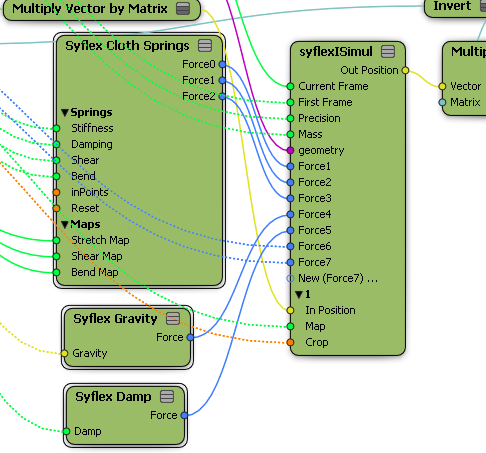Damping is a force that slows down the movement of the simulated cloth or curve object by dissipating its energy. You may, for example, want to use damping to make a parachute float gently down onto the ground, or create the effect of a cloth being dragged under the water.
There are two compounds that let you add damping as a force for the simulations: Damp and Damp Air compounds - see below for information on each one.
You can also set damping for only the cloth or curve springs by setting the Damping parameter value in the Syflex Cloth and Syflex Curve compounds - see Syflex Cloth.
The Syflex Cloth and Syflex Curve compounds (the basic deformation simulators) have the Damp force compound built into them, and are active by default. This lets you add an overall damping to the whole cloth or curve simulation. The intensity of the damp forces is proportional to the simulated object's velocity.
You can also use the Damp force compound on its own, such as if you're building your own simulation.
Create a simulated ICE tree for the cloth or curve object that you want to deform.
To give you an idea of which nodes you need to use to create your own simulation, edit the Syflex Cloth or Syflex Curve compound to see what's inside.
One of the main nodes that you need is the syflexISimul node, which controls the simulation calculations.
From the Task > Syflex tab in the preset manager in the ICE Tree view, drag the Forces  Syflex Damp compound into the ICE tree workspace.
Syflex Damp compound into the ICE tree workspace.
Plug its Force output into a Force port on the syflexISimul node.

In the Syflex Damp property editor, set the Damp strength.
The Damp Air compound is similar to the Damp compound except that the damp air force is proportional to the orientation of the cloth's polygon face in relation to the direction of the cloth's movement: a face that "slices" through the air (perpendicular to the direction of movement) is not affected by the damp air force, while a face that is fully against the direction of movement is slowed down.
You can also choose to which side of the cloth object you want the damping applied: both sides (such as for a flag), only the inside, or only the outside (such as for a T-shirt or any closed mesh). The sides are determined by the direction of the object's normals: outside is the side in which the normals are pointing (as in the image of the shirt below), and inside is the opposite of this.
Create a Syflex ICE cloth simulation — see Creating Syflex ICE Simulations.
Select the simulated cloth object and do either of the following:
Choose the Particles  Force
Force  Syflex
Syflex  Damp Air command from the ICE Tree toolbar.
Damp Air command from the ICE Tree toolbar.
This plugs the force node's Force output into the Force port of the Syflex Cloth node.
In the ICE Tree view, drag the Forces  Syflex Damp Air compound from the Task > Syflex tab in the preset manager in the ICE Tree view and plug it into a Forces port on the Syflex
Cloth node.
Syflex Damp Air compound from the Task > Syflex tab in the preset manager in the ICE Tree view and plug it into a Forces port on the Syflex
Cloth node.
In the Syflex Damp Air compound property editor, set the parameters.
 Except where otherwise noted, this work is licensed under a Creative Commons Attribution-NonCommercial-ShareAlike 3.0 Unported License
Except where otherwise noted, this work is licensed under a Creative Commons Attribution-NonCommercial-ShareAlike 3.0 Unported License